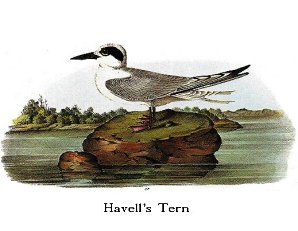
| Family XLII. LARINAE. GULLS. GENUS II. STERNA, Linn. TERN. |
Next >> |

Family |
HAVELL'S TERN. [Foster's Tern.] |
| Genus | STERNA HAVELLII, Aud. [Sterna forsteri.] |
I have several reasons for naming this Tern after Mr. ROBERT HAVELL, of
Oxford Street, London. In the first place I consider him as one of the best
ornithological engravers in England. Secondly, I feel greatly indebted to him
for the interest which he has always evinced in my publication, which, I dare
venture to assert, is the largest work of the kind that has hitherto appeared,
and the engraving of which has cost him much trouble and anxiety. Thirdly, I
consider myself entitled to express my gratitude in this manner, the individual
on whom I confer the honour being more deserving of it than many to whom similar
compliments have been paid.
I shot several individuals of this species out of a number congregated on
the broad eddies opposite New Orleans, in 1820. They were engaged in picking up
floating coleopterous insects; but after I had fired several shots, and was
rowing to those which had fallen on the water, the rest flew off. Since that
time it had not been my fortune to meet with any birds of the same species,
until I visited Texas in the spring of 1837, when two of them were procured.
HAVELL'S TERN, Sterna Havelli, Aud. Orn. Biog., vol. v. p. 122.
Adult, 15 1/2, wing, 10 8/12.
From Texas to South Carolina. Common. Migratory.
Adult in winter plumage.
Bill about the length of the head, rather stout, much compressed, acute.
Upper mandible with the dorsal line slightly declinato-convex, the ridge convex
at the base, very narrow in the rest of its extent, the side sloping at the
base, nearly erect and convex toward the end, the edges sharp and inflected, the
tip very narrow. Nasal groove rather short, but with a channel surmounted by a
ridge running from its anterior part to the edge of the mandible about half an
inch from the tip. Lower mandible with the angle very narrow and acute,
extending to beyond the middle, the outline of the crura a little concave, that
of the rest ascending and straight, a slight prominence or angle being formed at
their junction, as in Gulls, the sides erect and slightly convex, the edges
sharp and inclinate, the tip acuminate, the gap-line slightly arcuate.
Head of moderate size, ovate; neck of moderate length; body slender. Feet
small; tibia bare for seven-twelfths of an inch; tarsus very short, compressed,
anteriorly scutellate; toes small, slender; the first extremely small, the third
longest, the fourth much longer than the second; all scutellate above, the
anterior connected by reticulate webs, of which the inner is more deeply
emarginate. Claws moderately arched, compressed, very slender, that of the
middle toe much larger, and having its inner edge somewhat dilated.
Plumage soft, close, blended, very short on the fore part of the head.
Wings very long, narrow, and pointed; primary quills tapering to an obtuse
point; the first longest, the second half an inch shorter, the rest rapidly
graduated; secondaries short, incurved, obliquely pointed, some of the inner
proportionally longer and narrower. Tail of moderate length, deeply forked, of
twelve feathers, of which the middle are rounded, and three inches and a quarter
shorter than the outer, which taper to a slender point.
Bill black, with the base of the lower mandible tinged with brown, and a
very small portion of the tip yellowish. Iris brown. Feet orange-yellow; claws
dusky. Surrounding the eye, and extending toward the nape, is a broad band of
black; the fore part of the head, the lower eyelid, and all the under parts are
pure white; the hind part of the head and the nape are dusky-grey, mixed with
white. The rest of the upper parts are light greyish-blue, excepting the rump,
which is white, the primary coverts and quills as well as the tail-feathers and
their coverts are hoary, with the shafts white; but five of the quills are dusky
on the outer web, on the inner along the shaft, and on the inner margin toward
the end.
Length to end of tail 15 1/2 inches; bill along the ridge 1 7/12, along the
edge of lower mandible 2 4/12; wing from flexure 10 8/12; tail to end of middle
feather 2 8/12, to end of longest feather 6 1/12; tarsus (11 1/2)/12; hind toe
3/12, its claw 2/12; middle toe 10/12, its claw (4 1/2)/12.
This species differs from the Marsh Tern, Sterna anglica, in being less
robust, in having the bill a little longer and much more slender, its height at
the angle being (3 3/4)/12, whereas in that species it is (4 3/4)/12; in having
the tarsus shorter and much more slender, the feet yellow instead of being
black, the claws more slender, and the tail more deeply forked.
The figure in the plate, which is that of an adult bird yet in its winter
plumage, has the lateral tail-feathers obliquely truncate, but this was caused
by accident, for these feathers in my other specimens run to a narrow point. My
specimens from Texas are also in their winter plumage. One of them is coloured
as above; but the other is a young bird, which may here be described.
The bill is somewhat shorter and more tinged with brown; the lower parts,
the rump, the outer web of the lateral tail-feathers and the sides of the neck
are white; the wings as in the adult, but the primaries internally margined with
white, and the secondaries tipped with the same; the upper part of the head, and
the rest of the upper parts, are light yellowish-brown, intermixed with
greyish-blue, and there is the same black band on the side of the head as in the
adult.
| Next >> |